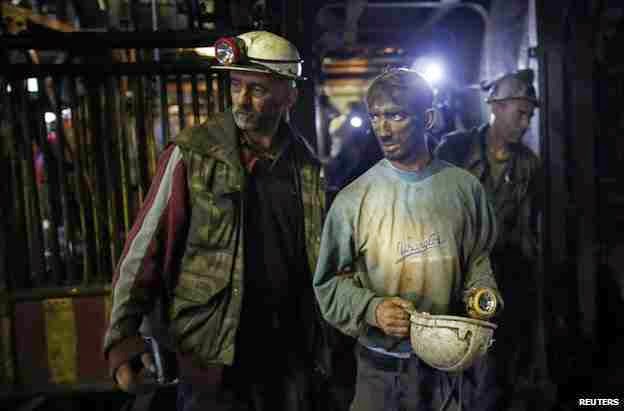Five workers have died and 29 more were trapped underground for about 24 hours following an explosion and cave-in at the Raspotocje Coal Mine in Zenica in central Bosnia and Herzegovina on Thursday 4 September 2014. The incident occurred following an Earthquake that struck near Serajevo, which is though to have triggered the blast. 22 workers were able to escape from the mine at the time of the incident, leaving 34 bellow ground, rescue workers have now freed 29 of these, none of whom is thought to be seriously injured, but attempts to recover the remaining five men have been abandoned, and they are thought to have been buried in the collapse. This is the third explosion at the Raspotocje Coal Mine this year, though the first one in which there have been fatalities. Sixteen workers were injured in the two previous events, raising serious questions about safety at the mine.
Survivors emerging from the Raspotocje Coal Mine on Friday 5 September 2014. Reuters.
Coal is formed when buried organic material, principally wood, in heated and pressurized, forcing off hydrogen and oxygen (i.e. water) and leaving more-or-less pure carbon. Methane is formed by the decay of organic material within the coal. There is typically little pore-space within coal, but the methane can be trapped in a liquid form under pressure. Some countries have started to extract this gas as a fuel in its own right. When this pressure is released suddenly, as by mining activity, then the methane turns back to a gas, expanding rapidly causing, an explosion. This is a bit like the pressure being released on a carbonated drink; the term 'explosion' does not necessarily imply fire in this context, although as methane is flammable this is quite likely.
The western Balkan Peninsula forms the eastern margin of the Adriatic Plate, a piece of the African Plate that has broken away and is now wedged into the southern part of the Eurasian Plate. This is being squeezed by the impact of Africa into Europe from the south, which is pushing western Italy, which sits on the Eurasian Plate, to the east, and Greece and Turkey, which sit on the Aegean and Anatolian Plates, to the west. This squeezing leads to uplift around the margins of the Adriatic Plate, in the Apennine Mountains of central Italy and the mountain ranges of the west Balkan Peninsula. This is not a smooth process, and earthquakes in the region are fairly common.
Outline map showing the approximate positions of the Eurasian (EU), Adriatic (AD) and African (AF) Plates. Di Bucci & Mazzuli (2003).
See also...
The United States Geological Survey recorded a Magnitude 3.9 Earthquake at a depth of 20.5 km in...
Three men have died following an accident at an unlicensed mine near the village of Toptepe in Şırnak...
At least 232 miners are known to have died and it is feared the death toll will rise much higher following an explosion and fire at a coal mine operated by Soma Kömür İşletmeleri A.Ş., the country's...
Follow Sciency Thoughts on Facebook.





